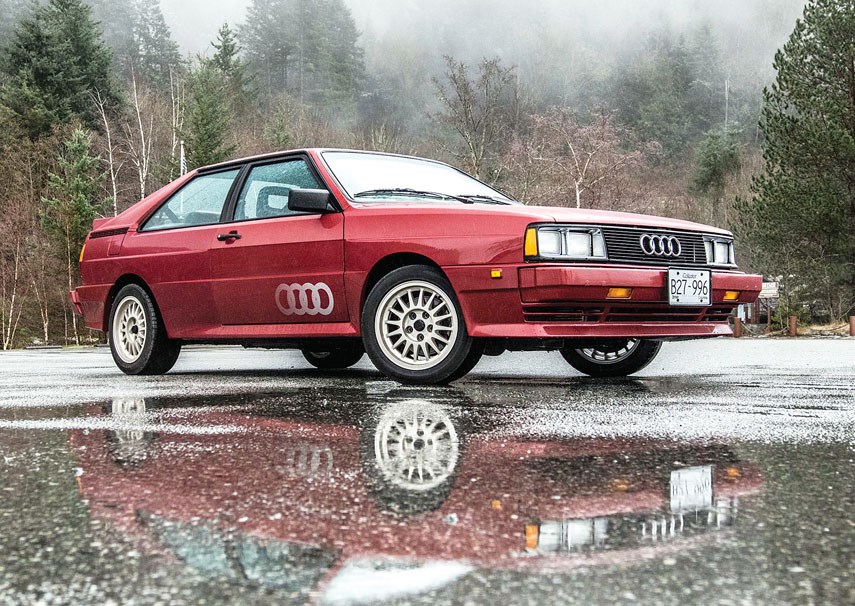I am beginning to suspect that Mother Nature has a sense of humour.
As an example, witness the bouquet of crocuses you could have picked early last week – and then the lovely snowfall that blanketed Highway 1 over the weekend. On a brief drive in North Vancouver I counted six vehicles abandoned on the side of the road.
Now, naturally the drivers of said vehicles probably didn’t find anything funny, and I do have a bit of sympathy for the owner of the old Ford Ranger, as a rear-wheel-drive pickup truck can be a bit of a handful in the snow. I’ve a little less sympathy for the owner of the 991-chassis Porsche 911, as those things are basically unstickable if you’ve got the correct winter tires on. Winter tires, people! If you can afford to drop $130,000 on a sports car, you can afford to put a set of seasonally-appropriate footwear on it.
As for me, I was driving a Sienna minivan, one with all-wheel drive and some pretty aggressive Bridgestone Blizzaks. I could have driven it to the North Pole for a quick hob-nob with Santa Claus. (Suggestion: never mind the Tickle Me Elmos, snow tires for everybody.)
The Sienna is one of the few minivans with all-wheel drive, but if you’re looking at buying a crossover – a more common choice for families these days – chances are it’s going to come with AWD. It’s something Canadian consumers have come to expect and demand. However, it wasn’t always like that.
First, a brief primer on the nomenclature. Four-wheel drive is generally considered to be the province of proper off-road machines, and is defined by the presence of a low-range gearbox. All-wheel drive means that all the wheels are driven at least part of the time, and is usually a little less robust.
The first true all-wheel-drive passenger car, apart from early experiments at the turn of the century, was the Jensen FF. FF stands for Ferguson Formula, with the Ferguson in question being Harry Ferguson, the Irish inventor and tractor magnate. But we’re not here to talk about him.
Instead, let’s have a look at the brand that first popularized all-wheel drive as both a safety feature and a performance tool. For it is to Audi that we must turn to find out why hardly any of the luxury marques bother to sell a sedan in Canada unless it’s got an AWD badge out back.
We have this very special machine to plot the way, a boxy mid-1980s coupe that has “Quattro” written on every available surface, including the floormats. Fans call this an Audi Ur-Quattro, the “Ur” meaning “first,” and the Quattro designation indicating that all four wheels are driven. Only 99 of these machines were delivered in Canada over its production run, and this very clean example happened to be originally sold out of Capilano Audi all those years ago.
In the 1970s, an Audi engineer with the thoroughly excellent name of Jörg Bensinger was testing a little four-wheel-drive off-roader called the Iltis in Finland. We’d eventually get the Iltis for the Canadian Forces, and while it’s probably a little on the small side for rugged military applications, Jörg was so enamoured of the Iltis’ ability to run circles around everything else in the snow, he hit upon the idea of packaging its all-wheel-drive system into a passenger car.
Doing so was a little tricky at the time, because space was limited and a centre differential was required. The centre diff was needed because in a tight turn, if the front and rear wheels are forced to turn at the same rate, the car will tend to buck and lurch. Audi’s solution was a clever third driveshaft that sent power to the front wheels, tucked inside a hollow secondary shaft.
Some fun shenanigans ensued at the executive level, as the occasionally stodgy VW board needed convincing. Ferdinand Piech, then head of Audi’s technical development team, had a grassy hillside soaked with water, and made board members drive up it first in regular Audi 80s, and then a Quattro-equipped car. The demonstration proved the technology’s worth.
The first car combined the grip of Quattro with that 1980s love of turbocharging. Our Ur-Quattro has approximately 200 horsepower from its turbocharged straight-five engine, and on a wet and slippery day on the Sea to Sky Highway, it spools up with a whistle and hurtles off without putting a foot wrong.
This combination of turbo thrust and excellent traction (and also box flares – doesn’t every car look better with box flares?) was enough to set the rally world alight. Audi suddenly emerged triumphant with their ace-in-the-hole, scrambling over loose surfaces as if they were paved. The Quattro was the chariot that would carry names like Michele Mouton and Stig Blomqvist to rally glory.
And, happily, that racing victory came to define Audi as a brand. Mercedes-Benz was for the Autobahn, BMW was for carving up the corners, and Audi was for quattro-based traction in all conditions. In the ideal garage, you could make an argument for a supple S-Class, a screaming E30 M3, and an Ur-Quattro for when the snow starts driving.
These days, some of the differentiation between brands has come apart a bit. Both BMW and Mercedes offer excellent all-wheel-drive systems, with the engineering for both coming down to software programming rather than the mechanics. You can still buy a rear-wheel-drive Bimmer or Mercedes, they’re just far less common.
So, with the proviso that even Quattro needs to have proper winter tires to stop and turn, I think we can all thank Audi for coming up with it in the first place. Sometimes Mother Nature likes to play a joke on us. With Quattro, you can make sure you’re laughing with her.



